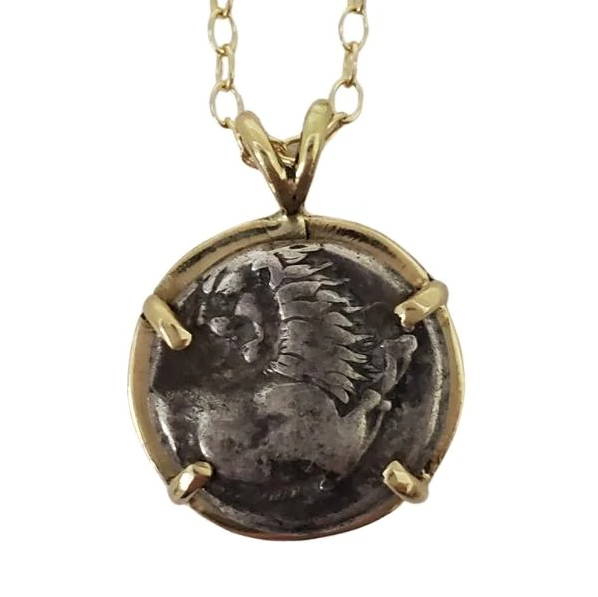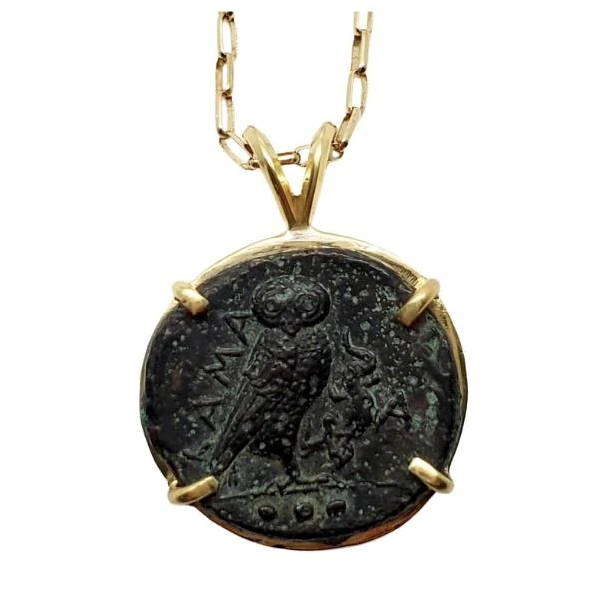Evolution of Coin Making in Ancient Greece
Ancient Greece as a civilization dominated the Mediterranean from the Greek Dark Ages of the 12th–9th centuries BC to the end of classical antiquity (c. AD 600). Do you know about the importance of coins for the Ancient Greeks and how the production and appearance of these coins evolved over time? Continue reading for the condensed history.
As opposed to today's modern coins, all coins from Ancient Greece were handmade. The designs were carved into a die (made of either bronze or iron), and then that die was used to stamp designs onto molded blank disks of gold, silver, or electrum. One of the most interesting things about Ancient Greek coinage is that coins took on the personalities of the Greek city-states they represented. For example, coins from Corinth depicted images of Pegasus, a mythical winged divine horse. Coins from Athens featured owls like this one, symbolizing wisdom and learning.
To understand the evolution of Ancient Greek coinage, you must first understand the four periods of art history for this civilization: the Archaic, the Classical, the Hellenistic, and the Roman periods. While the Archaic period lasted from the introduction of coinage to the Greek world in the 7th century BC until about 480 BC, the Classical period continued until the conquests of Alexander the Great in about 330 BC, and the Hellenistic period persisted until the death of Cleopatra (60 BC). The Greeks were defeated at the Battle of Corinth in 146 BC, and the Roman period commenced.

Archaic Period (7th Century BC-480 BC)
In Ancient Greece, coins were introduced for a very practical reason - to facilitate convenient payments, so commerce could flourish. Dating to between 625 and 600 BC, the earliest known coins were made of electrum, a naturally occurring alloy of silver and gold with trace amounts of copper. These early Lydian and East Greek coins were found under the Temple of Artemis at Ephesus. Later, King Croesus decided to replace the electrum coins with alternatives called "Croeseids", invented by Herodotus and made of pure gold and pure silver. More than half of the two thousand self-governing city-states in the Greek world issued their own coins, and some were used for inter-city trade. The coins even had circulation in the Achaemenid Empire or the First Persian Empire.
Crafted in silver, this Greek Cherronesos Silver Coin from 400-350 BC is a fine example of a coin from the Archaic period. An elegant lion with lovely details in his mane and face is turning to look over his shoulder.

Classical Period (480 BC-330 BC)
While coins in the Archaic period were utilitarian in their appearance, coins in the Classical period were crafted with a focus on improved technical precision and attention to detail. The larger cities in Ancient Greece would produce coins featuring portraits of their patrons gods, goddesses, and heros. Some coins even had inscriptions like the name of the origin city. The wealthier cities produced even more elaborate coins, like a large silver decadrachm (10-drachm) coin from Syracuse, a place that's heralded today for the numismatic art it produced during the Classical period.
This Greek Kamarina Owl coin is a fine example of one from the Classical period. Made of bronze, it features an owl on one side; the owl is looking forward and holding a lizard in its talons. In Ancient Greece, the owl represented wisdom and learning, traditionally accompanying the goddess Athena and enabling her to see and speak the whole truth. On the other side is a Gorgon, which was believed to ward off evil.

Hellenistic Period (330 BC-60 BC)
The Hellenistic Period was unique in that it represented a time when Greek culture was spreading across the known world. As a result, Greek traders were circulating Greek coins across a vast area, including Egypt, Syria, Iran, and northwestern India. Coins were being produced in larger sizes and more frequently in gold than silver. Another quality of Hellenistic coins that made them different from the coins of earlier periods is that they featured portraits of living people; the kings were not shy about nominating themselves to appear on coins.
The Greek Corinth Pegasus Silver Stater from 345-307 BC is a fine example of a coin from the Hellenistic period, especially since the Pegasus is beautifully centered on the disc. On the back of the coin is the goddess Athena wearing a Corinthian helmet pushed back from her face with a trophy behind her.

Roman Period (31 BC to 180 AD)
The Greek cities continued to make their own coins - called Roman provincial coins or Greek Imperial Coins - for several more centuries, even under Roman rule. It was simply more convenient and practical. These coins were never made of gold and only issued in silver, billon and bronze denominations, so their intrinsic values were lower than Roman imperial coinage.
Rome may have conquered Greece, but Greece will always remain the more innovative of the two when it comes to coin making. According to an article from Antigone Journal, "Rome was very much a latecomer among the monetarised societies of the Hellenistic Mediterranean." They didn't start producing coins until 300 BC, centuries after the Greeks. The Greeks had already established certain conventions, like the round shape and the use of someone's portrait.
Would you like to shop Ancient Greek coins for yourself? Visit this page to view our available pieces.
